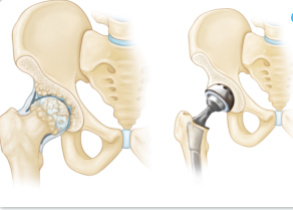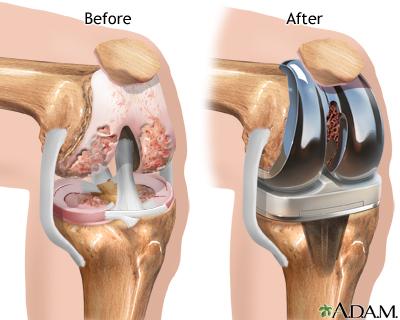Joints form in areas where at least two bones meet. The body has various types of joints in its different regions. For instance, hinge joints are those that straighten and bend such as the knee, while ball-and-socket joints are round and can be found on the shoulder or the hip. There are numerous conditions that cause an individual to undergo a joint replacement. A patient might decide to consider the procedure due to disability or pain. In most cases, what causes pain in joints is damage to the articular cartilage (Dummit et al., 2016). The damage can either result from fractures or arthritis or other conditions that may affect the cartilage found on the lining at the end of bones. If nonsurgical remedies such as activity modifications, physical therapy, and medications are not effective, a doctor can recommend a joint replacement procedure.
There are numerous complications associated with joint replacement surgeries. One of these issues is associated with blood clots, which is a serious complication. According to experts, there are two blood clot conditions that may arise and these include pulmonary embolism (PE) and deep vein thrombosis (DVT) (Joskowicz & Hazan, 2016). A pulmonary embolus is a situation where a clot detaches and moves to the lungs. Research states that indications of PE are unusually rapid heart rates or when an individual experiences shortness of breath (Dummit et al., 2016). On the other hand, deep vein thrombosis is a situation where a blood clot exists in the leg. An individual, in this case, may experience an unexpected increase in the swelling of the leg accompanied by calf tenderness (Fisher, 2016). When patients experience these types of symptoms after surgery, it is recommended that they contact their surgeons or seek other medical options.

Hip dislocation is the other complexity that emerges after joint replacement procedures, particularly at the hip. When the joint at the hip disjoints, the prosthetic ball emerges from its socket. According to experts, this condition can usually be rectified without surgery; however, this is a painful process that requires anesthesia and hip manipulation back into position (Fisher, 2016). Furthermore, research states that roughly 1 to 3% of individuals disjoin their hip after surgery; however, more than 39% of these people, dislocate their hip only once (Narra et al., 2019). To avoid hip dislocation, individuals may be requested to stop doing certain activities that increase the chances of injury.
Such issues as infections are common after experiencing a joint replacement. According to scientists, there are superficial wounds that may be treated using prescribed medication, but severe infections generally may need additional procedures (Jayakumar & Bozic, 2020). Statistics demonstrate that 1 to 2% of individuals suffer from infections after undergoing joint surgery (Jayakumar & Bozic, 2020). There is increased risk among different groups of people with infections mostly affecting diabetic, anemic, and overweight people. While the wound heals, the risk of infection reduces; however, it never completely diminishes. For this reason, individuals are often advised to take antibiotics to prevent potential infections that may arise after the procedure. Thus, it is important to take into account these implications before deciding to accept a joint replacement surgery.
After the procedure, an individual may be left with unequal leg lengths. Before conducting surgery, doctors often prepare adequately and very carefully to ensure that they do not interfere with the length of the patient’s legs. To optimize joint mobility, joint stability, and pain relief, orthopedic surgeons may decide to slightly elongate or shorten the client’s leg (Joskowicz & Hazan, 2016). After the operation, an individual may be advised to wear special shoes to remedy the difference in length. Patients may initially feel that one leg is longer than the other since they were used to walking or standing on a hip that was arthritic and had lost joint space. In these situations, patients are advised to be patient and with time they would become accustomed to the new hip.

Joint replacement procedures further may cause the prosthetic of an individual to loosen. During surgery, orthopedic doctors often replace the ball and socket to ensure that they rectify their condition (Koplan et al., 2021). After a while, physicians expect that the wound will heal in such a way that the porous metal implants would be covered. However, in some cases, this may not occur, thereby resulting in situations where the ball and socket are not sufficiently healed. As a result, the ball and socket become loose, since they have not bonded to the bone. Consequently, the patient may start to feel pain and issues such as deficient joint biomechanics, which may demand further operation. The reason for further procedures is because as time passes by, the prosthetic continues to loosen.
The other complication related to joint replacement procedures is that it may lead to damage to other tissues around the joint. Research states that during surgery, there are some situations where the surrounding tissues such as the nerves and the veins are damaged (Malik et al., 2020). However, these cases are very few with statistics approximating their occurrences to less than 1 % of the procedures (Narra et al., 2019). When this takes place, the patient may develop other conditions that may require further treatment. An important factor to consider, in this case, is that such an error may occur during surgery. Patients who begin to experience unusual pain or swelling around the wound should contact their surgeon or physician immediately to avoid further complications.
Although it is extremely rare, implant rejections are other challenges associated with joint replacement. Mental hypersensitivity or implant rejection occurs when the metal within the joint initiates a reaction in the body of the patient (Navathe et al., 2018). The effect is rare; however, there is some individual who might be allergic to the metal substance in the joint. In other cases, the reaction could be due to an autoimmune response by the body. Patients who develop such types of reactions may require corrective surgery to ensure that the device is replaced. Orthopedic doctors referred to this condition as difficult and challenging to diagnose (Tamaddon et al., 2018). As a result, it is recommended that physicians should consider implant rejection as the last resort after examining all possible conditions. Nevertheless, it is important to ensure that the patient recovers fully from the illness and, therefore, mental hypersensitivity should be examined along with other possible symptoms resulting from joint replacement.
In some instances, joint replacement surgeries can cause death to the patient. Although these incidences are rare, experts state that about 0.4% of patients die after one or two months of undertaking joint replacement surgery (Tamaddon et al., 2018). These occurrences are most common in elderly people or those suffering from blood-related problems. an individual may die due to complications resulting from blood clots. Additionally, an infection may create other medical issues that may be fatal. Thus, it is significant that when a patient experiences unusual outcomes after surgery, they must contact their surgeon or therapist to ensure that they rectify the problem at a much earlier stage.
Despite these risks, there are numerous opportunities that joint replacement provides. One of these opportunities is that patients are able to resume their normal functions and activities. Experts state that individuals who participate in sports are able to carry out small or low-impact activities after they have undergone surgery (Tarchini et al., 2017). To ensure that one fully recovers, it is essential that they undertake recommended physical therapy, which would help them heal. Individuals who have problems with walking or standing have the opportunity to rectify their situation. Despite the fact that there are some challenges that may develop as a result of surgery, patients can regain their ability to walk or stand steadily. Committed rehabilitation and physical therapy are programs that can enable an individual to have successful outcomes after surgery. Thus, for patients to fully recover, their overall health should be good, they have to reduce their activity levels, and finally, they have to have an excellent attitude towards recovery.
Joint replacement procedures have a lot of challenges, which may develop after the operation is complete. For instance, blood clots, which separate from the wound and travel to the lungs, thereby causing additional health problems to the patient. Surgeries related to hip problems can result in hip dislocation, which is a painful experience for the patient. On rare occasions, joint replacement may result in an individual being infected by other bacteria. Despite these challenges, there are opportunities that these operations present. Before surgery, patients may not be able to walk or stand due to pain. However, after surgery, these people may be able to regain their ability to perform normal functions. Additionally, joint replacement operations offer a patient the chance to restore their movement and continue with activities that they had once conducted.
References
Dummit, L. A., Kahvecioglu, D., Marrufo, G., Rajkumar, R., Marshall, J., Tan, E., Press, M. J., Flood, S., Muldoon, L. D., Gu, Q., Hassol, A., Bott, D. M., Bassano, A., & Conway, P. H. (2016). Association between hospital participation in a Medicare bundled payment initiative and payments and quality outcomes for lower extremity joint replacement episodes. JAMA, 316(12), 1267. Web.
Fisher, E. S. (2016). Medicare’s bundled payment program for joint replacement. JAMA, 316(12), 1262. Web.
Jayakumar, P., & Bozic, K. J. (2020). Advanced decision‐making using patient‐reported outcome measures in total joint replacement. Journal of Orthopaedic Research, 38(7), 1414-1422. Web.
Joskowicz, L., & Hazan, E. J. (2016). Computer-aided orthopedic surgery: Incremental shift or paradigm change? Medical Image Analysis, 33, 84-90. Web.
Knee Joint Replacement: MedlinePlus Medical Encyclopedia. (2021). MedlinePlus – Health Information from the National Library of Medicine. Web.
Koplan, K. E., Paxton, E. W., Bellows, J., Rabrenovich, V., Convissar, J., Wang, M. C., Grimsrud, C. D., & Navarro, R. A. (2021). Same-day joint replacement care: Achieving the quadruple aim. NEJM Catalyst, 2(2). Web.
Malik, A. T., Khan, S. N., Ly, T. V., Phieffer, L., & Quatman, C. E. (2020). The “Hip fracture” bundle—Experiences, challenges, and opportunities. Geriatric Orthopaedic Surgery & Rehabilitation, 11, 215145932091084. Web.
Narra, S. P., Mittwede, P. N., DeVincent Wolf, S., & Urish, K. L. (2019). Additive manufacturing in total joint arthroplasty. Orthopedic Clinics of North America, 50(1), 13-20. Web.
Navathe, A. S., Liao, J. M., Dykstra, S. E., Wang, E., Lyon, Z. M., Shah, Y., Martinez, J., Small, D. S., Werner, R. M., Dinh, C., Ma, X., & Emanuel, E. J. (2018). Association of hospital participation in a Medicare bundled payment program with volume and case mix of lower extremity joint replacement episodes. JAMA, 320(9), 901. Web.
Tamaddon, M., Wang, L., Liu, Z., & Liu, C. (2018). Osteochondral tissue repair in osteoarthritic joints: Clinical challenges and opportunities in tissue engineering. Bio-Design and Manufacturing, 1(2), 101-114. Web.
Tarchini, G., Liau, K. H., & Solomkin, J. S. (2017). Antimicrobial stewardship in surgery: Challenges and opportunities. Clinical Infectious Diseases, 64(suppl_2), S112-S114. Web.
